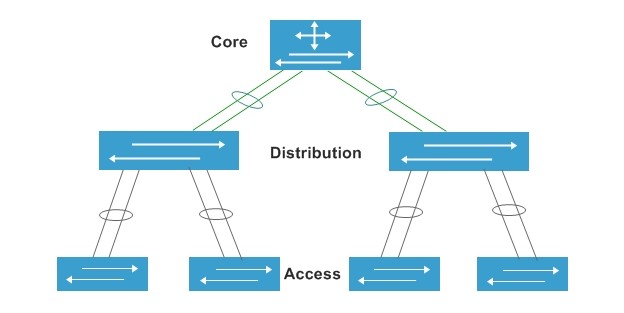The Cisco hierarchical model, also known as the hierarchical internetworking model, is a three-layer model for network design which is widely used in industry. It divides enterprise networks into three layers: core, distribution and access layer. As the lowest level of Cisco three-tier network model, the access layer is responsible for providing end user devices with a connection to network resources. Access layer devices contain a hub, multi-station access unit and switch. In this article, we will put emphasis on the access switch. In the meanwhile, some important features of the access switch will be introduced as well.
The Overview of Access Switch
Access switch is the only one that directly interacts with end-user devices. Because an access network switch connects the majority of devices to the network, it normally has the highest port density of all switch types. In spite of the high port count, access switch usually provides the lowest throughput per port. For example, most modern access switches come with a 10/100/1000Mbps copper Ethernet connection to end devices. While core and distribution switches commonly use between 10Gbps and 100Gbps fiber optic ports. An example of this is FS S2800-24T4F 24 port 100/1000BASE-T copper Ethernet switch. It is designed to meet the demand for cost-effective Gigabit access for enterprise networks and operators.
The Difference Between Access Switch and Other Switches
Access switch, distribution switch and core switch perform different functions. Distribution switches collect the data from all the access switches and then forward it to the core layer switches. A core switch is a high capacity switch that is generally positioned within the backbone or physical core of a network. In small networks where there are only a few servers and clients, access Ethernet switches are adequate without needing core switches or distribution switches. What is more, there is generally only one or two core switches used in a small or middle-sized network, but the distribution layer and the access layer might have multiple switches. The figure below shows where the access switches locate in a network.
The Important Features of Access Switch
Access layer switch facilitates the connection of end node devices to the network, such as PC, modems, IP phone, printers and etc. On this account, they offer many features that the upper tiers do not require. For example, an access switch can create separate collision domains for each connected node to improve performance. What is more, some access switches support Power over Ethernet. An access Gigabit PoE switch can supply power to many endpoint devices, including wireless access points and security cameras. Additionally, the access layer switch is more adept at interacting with endpoints from a security perspective. Port security, 802.1X authentication, and other security mechanisms are built directly onto access switch software.
Conclusion
In the construction of a network, there might be the access switch, distribution switch, and core switch. Although the access switch is not usually used in a large network, a smaller network is where access switch comes in. As the demand for higher Ethernet speeds and more enhanced link utilization increases, data center networking is requiring the 10GbE switch at the access layer to optimize performance. If you have demand for access switches, FS could provide and satisfy your needs.
Related Articles: FS.COM LAN Access 10G Switch Analysis





